Matador Network's Blog, page 1165
February 8, 2019
The best hiking trails in Hawaii

Pack more than just your flip flops for your next trip to Hawaii. The volcanic archipelago of the Pacific is home to some of the wettest, densest, and most beautiful trails that the US offers. From the big city life of Oahu to the laid-back garden isle of Kauai, there’s a trail for everyone. Here are the eight best trails throughout the Hawaiian Islands, and everything you need to see along the way.
1. Olomana Trail, Oahu
Round-trip: 5 miles

Photo: Pavel Tvrdy/Shutterstock
Oahu is the most visited of the Hawaiian islands, with more than six million visitors swarming to the island each year. Don’t expect your hike to be in solitude, but be sure to bring along your camera for portrait-worthy views. Olomana Trail, which starts on the quieter, beachside town of Kailua, offers three peaks, all of which are a steep, and at times dangerous, scramble. Look for wild pigs that scavenge the muddy forest at the beginning of the trail, then relish in the changing scenery as jungle gives way to an ironwood forest.
The heat of the climb comes from the boulder sections, technical enough to require a rope for extra support. The trail stays jungle-covered just enough that your view is mostly obscured until you reach the first climb. Your vista extends out toward the Pacific Ocean where a clear day will give you views of Na Mokulua, two small islands a half mile offshore. It’s possible to continue on the trail to the second and third peaks, but be warned: The trail can be treacherously dangerous in wet conditions and there are several places where a stumble can be fatal.
2. Koko Head, Oahu
Round-trip: 1.8 miles

Photo: Jeremy Red/Shutterstock
At less than two miles round-trip, it’s easy to write off Koko Head as a walk in the park. But with more than 1,000 stairs, this hike is difficult, in part due to the terrain itself. Your hike follows the Koko Head Railway, originally built during WWII to transport supplies up and down the bunker at Koko Head. As such, each step is awkward as you struggle to keep your foot on the railway planks. Don’t look down — the top section feels almost vertical. Though the hike itself isn’t beautiful, surrounded as it is by dry, scrubby brush, take a minute to cool your heart rate and enjoy the view from the top. Honolulu’s aquamarine waters lay far below.
3. Kalalau Trail, Kauai
Round-trip: 22 miles

Photo: IndustryAndTravel/Shutterstock
If you’re a serious hiker, chances are you’ve secured a permit to the Kalalau Trail well before you fly to Kauai. The Kalalau Trail, an 11-mile (one-way) hike along the Na Pali Coast is as good as it gets for strenuous, but rewarding, hiking. The trail begins with a two-mile section of yellow-dirt trail that provides stunning views of turquoise waters. At Hanakapi’ai, turn inland to visit a waterfall or continue on — with the required permit, purchased far in advance — to traverse the hilly cliffside trail. Not an endurance hiker? Camp at Hanakoa, roughly the halfway mark, or continue to the end of the trail at Kalalau Beach. Your bonus? Getting to hike back. As of January 2019, the trail is temporarily closed due to damage from heavy rain, but it will hopefully reopen soon and it’s well worth planning ahead for this bucket-list hike; check the state park website and plan accordingly.
4. Alakai Swamp, Kauai
Round-trip: 7 miles
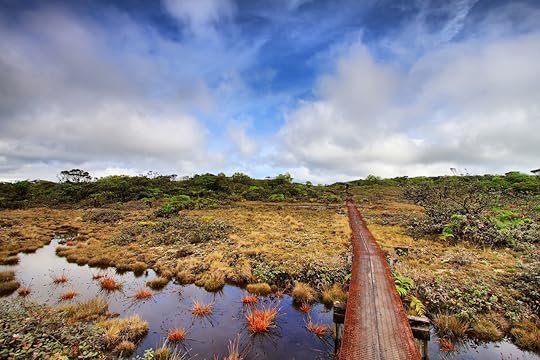
Photo: Marisa Estivill/Shutterstock
Tucked into Waimea Canyon, Alakai Swamp sits more than 4,000 feet above the Na Pali Coast. As such, this rainforest remains damp year-round, meaning that many a boot have been sucked off due to the mud that coats the otherwise green scene. In recent years, a boardwalk has been installed which makes the hike more doable — all the better to get to Kilohana Lookout for a view, if you’re lucky enough to get a clear day. Even without the view the hike is special. Alakai Swamp is a unique “montane wet forest,” one of only three found on the Hawaiian Island with several bird species that can be seen, like the ‘i’iwi, a honeycreeper with a large curved bill.
5. Kīpukapuaulu, Hawaii
Round-trip: 1.2 miles

Photo: Doug James/Shutterstock
Volcanoes National Park, which sits at the southern tip of the Big Island, once offered visitors trails that traversed craters and lava tubes. Unfortunately, due to Kilauea’s seismic activity and lava flows most of the park was closed for much of last year and several of the best trails are still closed. Nonetheless, the park is not to be missed and continues to offer hiking unlike you’ve seen. The Kīpukapuaulu Trail — we dare you to pronounce it — features ‘ōhi’a trees, a vital plant for the endemic and brightly colored apapane and akohekohe birds. Bring a pair of binoculars to spot them concealed amongst crimson-hued flowers. At 1.2 miles round-trip, this isn’t a hike that requires endurance, but that’s for the best as you marvel at the thick green canopy overhead. Part of this hike’s beauty is in its contrast to the Kilauea crater. Post-hike, drive the recently opened Crater Rim Trail to witness a scene more evocative of Mars than a tropical oasis.
6. Waipi’o Valley, Hawaii
Round-trip: 3 miles

Photo: Annettes Photos/Shutterstock
If you’re looking for a short but steep workout, the Waipi’o Valley offers a 25 percent grade — at times up to 40 percent — with one of the most expansive and sacred sites on the Big Island of Hawaii. Located on the Hamakua Coast, on the northern end of the island, Waipi’o Valley has a long history in Hawaiian culture and was the childhood home of King Kamehameha I along with thousands of native Hawaiians; estimates range between 4,000 and 10,000 people. Today the valley is inhabited by just over 100 Hawaiians who continue to work on their loi kalo, or taro terraces. While it is possible to drive down into the valley, we recommend hiking, both for the chance to see wild horses and to eventually wind your way through to the black-sand beach. Rest up: You’ll need it on the way back.
7. Pipiwai Trail, Maui
Round-trip: 4 miles

Photo: MNStudio/Shutterstock
After spending several days snorkeling around Maui, take a break from the sun and head inland to Waimoku Falls and Pipiwai Trail, a four-mile trail that winds through thick groves of bamboo and around tangled banyans in Haleakala Crater National Park. While Waimoku Falls, the final point of the hike, offers 400 feet of cascading blue water, there are several additional waterfalls and streams to see along the way. The trail can get muddy, but lucky for you, a wooden boardwalk has been installed, making for a cleaner — and dare we say more fun — experience. Take the opportunity to visit the Haleakala Crater summit post-hike, savoring the cindered terrain. Sunrise and sunset can be spectacular, but the real show comes at night when the stars look close enough to touch.
8. Kalaupapa, Molokai
Round-trip: 7 miles
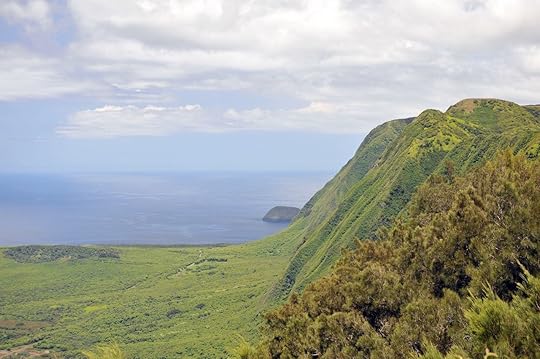
Photo: norinori303/Shutterstock
Molokai, known as the Friendly Isle, is the least visited of the larger Hawaiian islands. Despite much of the island looking arid, Molokai is home to dense old growth rainforest. Several of the island’s hikes require guides, but Kalaupapa National Historical Park offers several trails and the chance to understand Molokai’s darker history. Kalaupapa was once a village where those suffering from Hansen’s disease, better known as leprosy, were sent to live in isolation. Prior to this, native Hawaiians lived on the Kalaupapa peninsula for hundreds of years. A guided tour will provide you with a required permit as well as the history behind this special place, but you’ve still got a 3.5-mile hike with 2,000 feet of steep descent awaiting. 

More like this: How to choose the right Hawaiian island for your outdoor passion
The post 8 stunning trails you need to hike in Hawaii appeared first on Matador Network.

Habits all bartenders have

We all develop certain behaviors thanks to the influence of our work — nurses tend to wash their hands more often than is necessary and firefighters check the stove buttons a little too often. Bartenders are no exception. Over time, we carry the things we repeatedly do at work into real life. From knowing exactly how you like your Negroni to refusing to split a check, here are seven habits you pick up bartending.
1. Having extreme selective hearing
Like Pavlov and his dogs, bartenders are trained to listen for certain sounds and respond accordingly. It can be the sound of the front door opening, the printer printing out a drink ticket, or a bar stool sliding back. When you hear it, you stop what you’re doing and spring into action. On the flip side, we’re also experts at tuning things out, particularly the sounds of bar guests’ conversations.
2. Always being prepared for any situation
When you’re bartending, you never know how busy your bar will be because every night is a little different. The absolute worst thing you can do is to assume that it’ll be a slow night. Because if you do, a sudden rush will leave you scrambling. For this reason, we always prepare to be busy. We carry this spirit of preparedness into all areas of our lives. A simple trip to the beach means packing three different types of sunscreen, a book, a magazine, a frisbee, a flask, and a giant bottle of water.
3. The ability to order clearly
The biggest pet peeve of busy bartenders is indecisive guests. We’re happy to offer suggestions but at the end of the day, just pick something already! So we try to remember this when it’s our turn to order things. Be direct, clear, and try to order everything at once. The more customizations and additions, the more likely it is that the staff or kitchen will make a mistake.
4. Knowing how we like our drinks
On a related note, one of the perks of being a bartender is having the opportunity to develop your palate. Bartenders know how to order martinis, for example, because we know how we like our martinis. We have to bite our tongues when we go out with non-bartender friends because they’ll ask five questions just to order one drink.
5. Having respect for expiration dates
The Department of Health is a bartender’s “He Who Shall Not Be Named.” We religiously check expiration dates on juices and milk because the one day that you forget to is the day that the DOH does a surprise inspection. In our everyday lives, when we visit friends and their fridges are full of expired condiments and old milk, it’s enough to cause a mild panic attack.
6. Being a radio dictator
When you bartend, music is your fuel. A bad song can cause your energy level to crash and derail your flow. You always need to be in control of the playlist. This trait isn’t as attractive, however, on road trips and at house parties. We have to remember that not everywhere is our bar.
7. Never splitting checks
That doesn’t mean that we won’t all contribute money to a check, but a table of bartenders will never throw down six credit cards to split the bill. Either we all chip in cash, Venmo each other, or take turns treating our friends. We know how annoying it is for a server or bartender to have to split checks on multiple cards, so we try to avoid that situation as a point of pride. 

More like this: The 9 absolute worst things you can do in a bar
The post The 7 habits you pick up bartending appeared first on Matador Network.

Postcards sent from Galapagos Island

The Galapagos Islands take “snail mail” to a whole new level. In 1989, Peter and Varna Chadwick were on vacation in the Ecuadorian islands when they sent postcards to themselves at their home in Manchester, England, as a souvenir. The postcards didn’t arrive; however, last month, the home’s new owner, Kevin Thewlis, received them. He tracked down the Chadwicks, who now live in Stockton-on-Tees, to reunite them with their long-lost postcards.
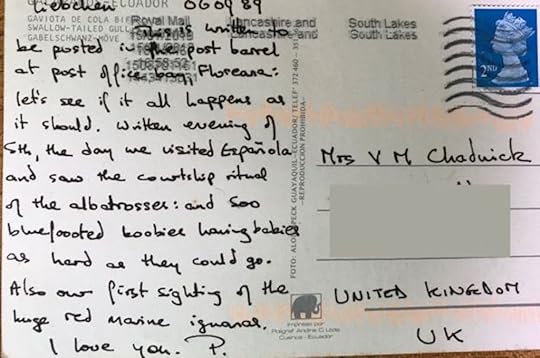
Photo: Peter Chadwick
The cards had been sent via the Galapagos’ “barrel post” system, wherein the post is dropped in beachside barrels and picked up and conveyed to their next destination by islanders who happened to be heading that way. Peter Chadwick believes that although it took him 30 years to finally receive the postcards, they probably reached the shores of England years ago, and were probably delayed by mishandling. “Someone must have stuck them in a file intending to post them,” he told the BBC, “and then come across them 30 years later.” So much for “Royal Mail.”
The islands are known for their slow giant tortoises, but as the BBC points out, “even those tortoises, traveling at a typical speed of 0.16 mph, could have delivered the postcards faster.” 
H/T: BBC News

More like this: 10 things you can do in the Galapagos Islands other than look at tortoises
The post Postcards from Galapagos Islands take 30 years to arrive appeared first on Matador Network.

February 7, 2019
Best Bourbon Street bars in NOLA
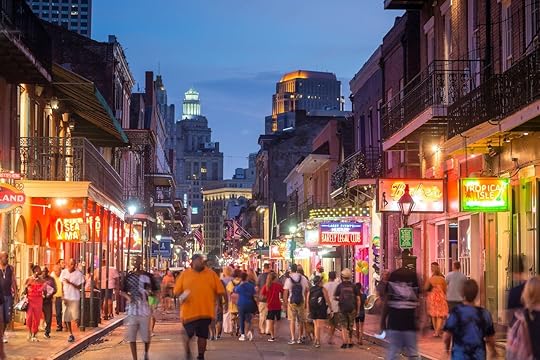
New Orleans is, in every way, the city that most embraces that high-low bar life. Not just in Louisiana, but in the whole United States. You can drink at a gilded cocktail haven where storied classic cocktails were invented, then stumble outside for a hurricane cocktail consumed right there on the street — yes, it’s legal to drink on the street here, which is obvious as soon as you arrive. Nothing quite exemplifies this dichotomy like Bourbon Street, which is smack in the middle New Orleans’ French Quarter.
This small part of New Orleans is both its most famous and its oldest. It’s lined with strip clubs, dives, and live music spots. Some are worth your time, many others are not. Regardless of how you look at it, though, you’re doing Bourbon Street wrong if you’re only going to one bar. Take advantage of being able to walk place to place with a drink in hand. These are the 14 bars on Bourbon Street that you must go to at least once.
Note on selection: Only bars physically located on Bourbon Street, not the broader French Quarter, were considered. Since this is a town with plenty drinking history and passion for beverages, there will surely be some strong opinions about what is left off. These are simply the most essential ones to visit — feel free to fight us, but only after we’ve had a hand grenade.
Tropical Isle

Photo: Kristi Blokhin/Shutterstock
Other than the hurricane, NOLA’s most famous oversized and overly strong drink is the hand grenade. There’s only one chain of bars where you can legally get a true hand grenade (seriously it’s trademarked and aggressively policed) and that’s Tropical Isle. The bar’s tagline is, “Where the fun begins and memories last forever,” but do yourself a favor and only have one hand grenade if you want to keep those memories. There’s a livestreaming webcam at the bar on the corner of Bourbon and Orleans, so you can show the world all of your great Bourbon Street decisions.
Locations: (Original) 600 Bourbon Street, (Bourbon) 721 Bourbon Street, (Bayou Club and Music Bar) 610 Bourbon Street, and (Little Tropical Isle) 435 Bourbon Street
Funky 544
Think New York’s famous disco club Studio 54, but with an extra “4” and a distinct NOLA clientele. There’s a raised stage for regular live music (rhythm and blues is proudly highlighted on the bar’s entryway sign), and the drinks are intended to keep you dancing. You’ve got to have a way to burn off all the calories from those sweet cocktails, after all.
Location: 544 Bourbon Street
The Beach on Bourbon

Photo: The Beach On Bourbon/Facebook
Not a literal beach, but New Orleans is one of those places where you turn a place into whatever you want it to be. The Beach on Bourbon claims to have the largest dance floor out of all the bars on Bourbon Street. If you’re feeling like catching the vibe without catching anything from the people dancing downstairs, head up to the VIP balcony section on the second floor. It’s also a place to catch a game with multiple TVs because New Orleans is very much a sports town.
Location: 227 Bourbon Street
Bourbon Pub and Parade
Open 10:00 AM to 3:00 AM, Bourbon Pub and Parade is a gay bar that’s been open since 1974. Downstairs is the “pub” part while upstairs is the “parade.” There are events and themes every night, including karaoke, drag shows, and Throwback Tuesdays with hits from the 80s and 90s. Screens stream music videos all night long on Fridays and Saturdays.
Location: 801 Bourbon Street
Bourbon O

Photo: Bourbon “O”/Facebook
Get away from the cheap beer for a bit at Bourbon O. It started using fresh-squeezed citrus and housemade ingredients in 2013, and the quality shows. It has an impressive whiskey list and a healthy list of classic cocktails. This means that you’ll be paying more for the drinks than you will at any other bars along the street, but it’s worth it. Live jazz music every night starts at 8:00 PM.
Location: 730 Bourbon Street
Famous Door
Opened in the 1930s by a boxing promoter who wanted to copy a Manhattan nightclub, the Famous Door quickly became known as the spot to go for New Orleans jazz. Its musical reputation has died down some and cover bands are normally on the playbill, but it’s still a fun bar to hit for music, dancing, and drinks.
Location: 338 Bourbon Street
Saints and Sinners

Photo: Saints and Sinners/Facebook
Channing Tatum’s bar Saints and Sinners has a lot less of a Magic Mike atmosphere than you may be hoping for, but it’s still worth a visit. It’s part bar, part restaurant, and an all-around enjoyable experience. It’s styled after old red-light district prostitute houses and burlesque halls, and a portion of the profits are donated to charities around the world.
Location: 627 Bourbon Street
Bourbon Cowboy
Bourbon Cowboy is here to remind you that, despite how different the bayou feels, you’re still in the deep South. Come for people flying off the mechanical bull in various states of drunkenness, stay for the balcony on the upper floor. The music is a mix of country, rock, and pop, and you can buy $3 tooters (pre-mixed shots in small vials) from hostesses walking around the bar. Drink enough of them and you might just find yourself on the bull.
Location: 241 Bourbon Street
Lafitte’s Blacksmith Shop
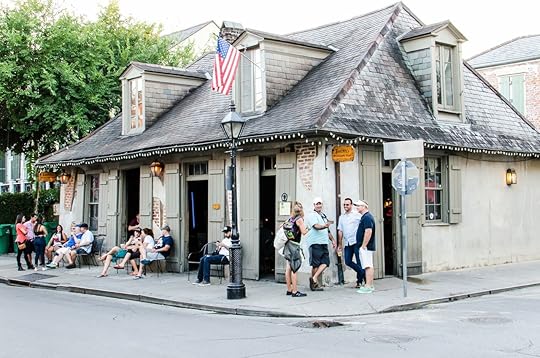
Photo: Andriy Blokhin/Shutterstock
Lafitte’s Blacksmith Shop is allegedly the oldest building to house a bar in the country. The name comes from Jean Lafitte, a privateer and slave trader who, according to legend, used the building as a storehouse in the early 1800s. Today, it’s a dim and dank drinking hole. Take a trip into the past and order a beer or a simple mixed drink in a plastic cup. Be ready to adjust your eyes, though, as you’ll be drinking by candlelight.
Location: 941 Bourbon Street
Oz
There’s no shortage of strip clubs on Bourbon Street and in New Orleans in general. The vast majority of those only have women on stage. Not so at Oz. Oz is a gay dance club with live strip shows, a balcony bar, and nightly events like drag shows and comedy shows.
Location: 800 Bourbon Street
Old Absinthe House
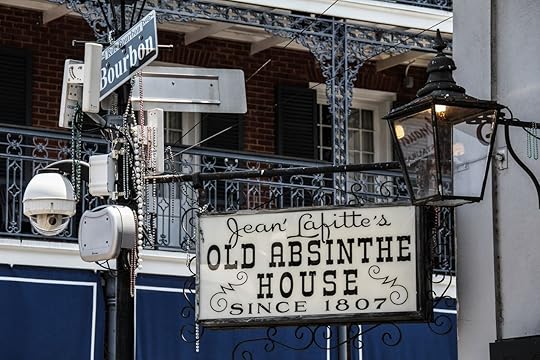
Photo: Atomazul/Shutterstock
The Old Absinthe House has been around since 1807. It, too, has a connection with privateer Jean Lafitte. According to legend, the bar is where Lafitte and Andrew Jackson negotiated a treaty to join forces against the British in the Battle of New Orleans during the War of 1812. There’s no record of what they drank, but the deal worked. The drink to get here is the signature Absinthe Frappe, which was invented in 1874 and quickly became favorite of writers like Oscar Wilde and Mark Twain.
Location: 240 Bourbon Street
Fritzel’s Jazz Club
Since 1969, Fritzel’s has been inviting jazz players and jazz lovers from around the world. The food might not be anything to write home about and the drinks can be hit or miss, but you will stay for the live music. Just keep in mind it can get crowded during popular sets.
Location: 733 Bourbon Street
Cats Meow
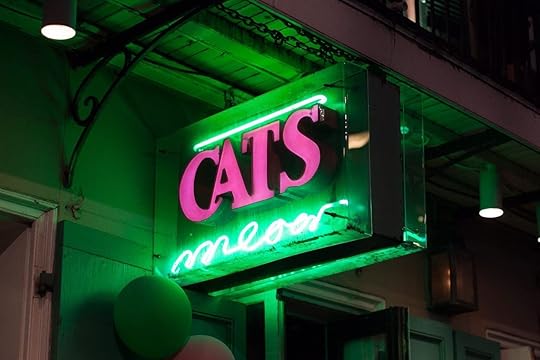
Photo: Cats Meow/Facebook
The Cats Meow has been around since the 1990s, and it’s become a karaoke institution. You make the music here — or someone else can, and this includes famous stops from the likes of Miley Cyrus, Charles Barkley, Seal, Weird Al Yankovic, Stormy Daniels, and more. Go early for the three-for-one happy hour offered every day from noon to 8:00 PM, which is just enough to get you through any bad singers.
Location: 701 Bourbon Street
Bourbon Bandstand
Stop by to see the band B Street Benny. Bourbon Bandstand has live music or a DJ every night, as well as a regular happy hour and drink specials on the upper balcony bar. It’s rowdy both day and night, and the music is always set on “the hits.” Luckily, there’s plenty of room on the dance floor to show off all your moves.
Location: 441 Bourbon Street 

More like this: 6 ways to save money on your trip to New Orleans
The post 14 Bourbon Street bars you must visit when in New Orleans appeared first on Matador Network.

The best dive spots in Bali

The diverse marine life, warm waters, and mild currents in Bali have been attracting underwater explorers for decades. Home to some of the world’s most fascinating sea creatures, including mola mola and whale sharks, and man-made underwater coral gardens, the island’s most unique diving spots are a world apart from the hustle and bustle of Bali’s tourist areas. Here are the island’s three best locations to take the plunge.
Pemuteran

Photo: Tropical studio/Shutterstock
The Pemuteran Village Marine Protected Area in northwest Bali is home to the world’s largest coral restoration project. Spread over two hectares, the underwater park started out as a small conservation venture to rebuild the reefs destroyed by dynamite and cyanide fishing. Today, it encompasses over 90 striking coral nursery sculptures that serve as an ideal setting for fascinating aquatic explorations.
Masterminded by marine scientists Thomas Goreau and Wolf Hilbertz in 2000, the Karang Lestari reef restoration project uses Biorock technology to promote coral growth. The picturesque statues in the area have been created by attaching broken coral pieces from nearby reefs to steel frames placed at the bottom of the ocean floor. Low voltage electrical current was then passed through the frames to accelerate coral growth. Today, the man-made structures support hard and soft coral, sponges, sea fans, and tunicates. The underwater sculptures also attract a huge variety of marine life, including catfish, humbugs, frogfish, and eels, as well as more unusual species such as Pegasus seamoths and fingered dragonets.
While Pemuteran has around 15 diving spots, most of the coral sculptures are spread over a small number of locations. One of them is the Temple Garden Biorock project dive spot, which you can access right from the beach. The site features structures lined at depths between 50 and 100 feet, including a small temple complex, statues of Buddha and Ganesha, and an ornate Balinese gateway. A more recent addition to Pemuteran’s mini-gallery, the Garden of the Gods, was constructed in 2014. The diving site, which lies around 1,300 feet offshore, has been inspired by the Balinese legend of Dewata Nawa Sanga. The garden’s main attraction is a statue of Shiva sitting on the back of a turtle with various Balinese gods positioned around him. More accessible Biorock structures are also located around 300 feet from the beach, at depths between 10 and 25 feet.
Tulamben

Photo: DJ Mattaar/Shutterstock
The USS Liberty shipwreck just off the coast of Tulamben in northeast Bali might just be the most popular diving location on the island. Built in 1918 as a cargo ship, the Liberty was used to transport goods and animals before it was fitted with guns and used as the USAT (United States Army Transport) Liberty. In 1942, the freighter was torpedoed by a Japanese submarine about 12 miles from the Lombok Strait. The badly damaged ship was towed to the port of Singaraja in north Bali for repairs, but the vessel took in too much water and ended up beached in Tulamben. The freighter was moored on the beach for 21 years before the eruption of Mount Agung pushed it into the sea in 1963.
Today, the Liberty lies on a sandy slope just 100 feet offshore, making it easy to access from the beach. The hull of the 400-foot-long wreck, which is around 15 feet below the surface, is great for novice divers and snorkelers. Meanwhile, the shipwreck’s deck, at a 100-foot depth, makes an exciting playground for more experienced divers. Thrill-seekers can swim through the wreck’s large cargo hull, which teems with aquatic life. Around 400 species of fish are estimated to have taken refuge in the vessel, including barracuda, parrot fish, trumpet fish, and grouper. Rare species such as mola mola, whale sharks, and pigmy seahorses have also been spotted here.
Menjangan Island

Photo: Jhon R. Tambunan/Shutterstock
Located in West Bali National Park, a 30-minute boat ride from northwest Bali, Menjangan Island has been an international diving destination since the 1970s. The tiny island is famous for wall diving. The walls start at 30 feet before plunging to the depths between 85 and 200 feet. The walls — complete with caverns and overhangs — are covered with picturesque coral, gorgonians, and sponges. These, in turn, attract a large variety of fish, such as eels, pufferfish, wrasses, and groupers.
Around eight diving spots surround the small island, each full of abundant marine life. Anker Wreck, on the northwestern side of the island, is named after the coral-encrusted anchor that lies around 20 feet deep. It belongs to the 150-year-old wreck of a wooden boat that lies on the seabed at a 130-foot depth. While little of the wreck and its cargo remain, the tranquil area is packed with sand-dwelling creatures, nudibranchs, and gorgonias. Also on the northeastern side of the island, Eel Garden features a wall that goes down to a depth of 80 feet and ends in a shallow area populated by a huge colony of garden eels. Here you can sometimes spot large pelagics, such as turtles and whitetip reef sharks. Another interesting location is the Pos 2 Dive Site, where a gentle current takes divers down to 80 feet and along the wall to an upwelling of cold water that attracts turtles, manta rays, and mola mola. 

More like this: Shark diving isn’t as scary as you think — but it is really gross
The post The absolute best places to dive in Bali appeared first on Matador Network.

Best breakfast burritos in the US

Visiting a bar or two is one of the best ways to see a city, but a late night can seriously deter early morning plans. That’s why it’s always important to be on the lookout for a hearty breakfast that can combat an evening of many drinks. Enter the breakfast burrito, which is substantial enough to keep us full until lunch, even if we’re walking miles in a new city.
The breakfast burrito was invented, so the story goes, by a Santa Fe, New Mexico restaurant called Tia Sophia’s in 1975. Or at least it was the first place to specifically call it a “breakfast burrito” on the menu. A lot of things have changed since then, including the fact that you can find an at least halfway decent breakfast burrito in any mid-size town. But halfway decent doesn’t always cut it. If you’re traveling in the cities listed below, make it a point to eat a breakfast burrito. These are the best breakfast burritos in the country, from California to New York and everywhere in between.
Tia Sophia’s — Santa Fe, New Mexico

Photo: Tia Sophia’s Restaurant/Facebook
Always respect the original. Not much has changed about the family-owned classic diner, and it still serves the same belly warming northern New Mexico fare as it did when it first opened. Eggs are optional in Tia Sophia’s breakfast burrito, but all burritos come stuffed with hash browns and your choice of meaty goodness. Ham, sausage, and bacon are all options — as well as beans for our veggie friends — but order it with fried bologna if you really want to eat like a local. Top it off with Tia Sophia’s red or green chili if you woke up with a big appetite.
Scott’s Kitchen — Kansas City, Missouri

Photo: Scott’s Kitchen and Catering at Hangar 29/Facebook
Barbecue aficionados might be familiar with Scott’s Kitchen, which competition barbecue man Scott Umscheid opened in 2017. While you’re sure to find meaty favorites like ribs, pulled pork, and brisket — along with sides such as BBQ beans and jalapeño apple slaw — Scott’s Kitchen is known for its large menu of tacos and burritos. The restaurant is close to the Kansas City airport, so stop in for a breakfast burrito when you land or before taking off. While you can’t go wrong with any meat to accompany the scrambled eggs, potatoes, and homemade salsa, we suggest trying the burnt ends or housemade chipotle ghost pepper sausage if you can take the heat.
Foster Sundry — Brooklyn, New York

Photo: Foster Sundry/Facebook
Foster Sundry is a Bushwick, Brooklyn shop that has everything you need to make an excellent meal at home, including a butcher, cheese counter, and a curated selection of gourmet goods and craft beer. But what you really need to order at Foster Sundry is the breakfast burrito. It’s packed with cheddar, housemade chorizo, scrambled pastured eggs, pepper, onions, jalapeños, and crispy fried potatoes. One of these bad boys will fuel you up for a full day of exploring New York City.
Kono’s — Haleiwa, Hawaii

Photo: Kono’s/Facebook
Kono’s started out with the Haleiwa location in 2002, and has since grown to three locations across Hawaii. The mini-chain is famous for its 12-hour, slow-roasted Kalua pork that’s served morning, noon, and night. Kono’s is also known for the Breakfast Bombers, aka burritos, that are stuffed with roasted pork, bacon, Portuguese sausage, potatoes, eggs, and cheese. Each Kono’s location opens at 7:00 AM, so you can stop in for a Breakfast Bomber before a long day of catching waves, lounging on Hawaii’s best beaches, or hiking the island’s many beautiful trails.
Cofax — Los Angeles, California

Photo: Cofax Coffee/Facebook
Ask a Los Angeles local who makes their favorite breakfast burrito in the city, and they’ll likely point you in the direction of Cofax. This Fairfax coffee shop opened in 2014 and quickly realized it needed to serve breakfast. And so the morning burrito was born. Each one is stuffed with slow-smoked potatoes from Cofax’s sister restaurant, Bludso’s Bar & Que, and you can choose to add things like veggies, pastrami hot links, and avocado to the mix. Pair it with a freshly brewed Stumptown coffee and a big pair of sunglasses and these breakfast burritos will help you swiftly recover from any hangover.
Bonfire Burritos — Golden, Colorado

Photo: Bonfire Burritos/Facebook
Denver has a lot of solid breakfast burritos, but the best in Colorado can be found in nearby Golden. Although Bonfire Burritos has been around for quite some time, a group of friends who grew up eating at the food truck decided to buy it in 2013 when the original owner retired. They spent time mastering the recipes, and people still flock there for their hearty, green chile-smothered burritos. All of the breakfast burritos are filled with rice, beans, and green chile, and you can choose from a variety of styles like the Javelina, which is stuffed with pork, pineapple, cotija cheese, diced jalapeño, and jalapeño-pineapple crema. Visit for a hearty breakfast before hitting Colorado’s best ski spots. 

More like this: The absolute best breakfast spots in New York City
The post The 6 best breakfast burritos in the US appeared first on Matador Network.

Romantic spots in New York City
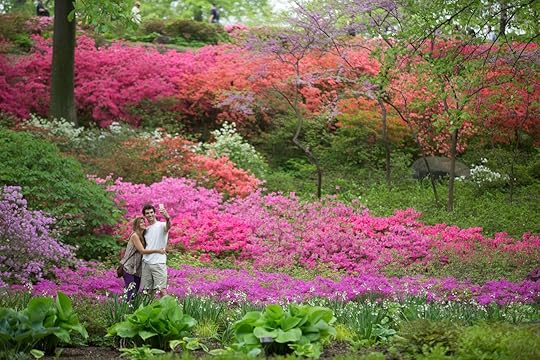
It may not be the City of Love, but New York City is quite romantic in its own right. Places like Central Park, the Empire State Building, and well-known restaurants and bars are typical romantic go-tos here, and while visiting Bethesda Fountain for people watching or walking across the Brooklyn Bridge are tried-and-true ideas, there’s so much more underneath the surface. In a city that spans 302 square miles, there are tons of dreamy places for a unique date or Valentine’s Day to remember. Here are six of our favorite underrated romantic spots around New York City.
1. Randall’s Island Cherry Blossom Festival

Photo: Randall’s Island Park/Facebook
If you can’t make it to Japan for the cherry blossom season, New York has several locations of its own where you can view the bloom. One of the best spots in the city for this is the Brooklyn Botanic Garden, but its popularity means that during its annual cherry blossom festival, it’ll be packed to the brink. Instead, head to Randall’s Island with your special someone to get all the fun of a cherry blossom festival with flower viewing, paper flower making, face painting, kite flying, balloon fishing, and performances — without massive crowds. Usually, there’s food available but pack your own meal and you can have a lovely picnic under the pink flowers. And when you want time alone, Randall’s Island is large enough that you can have space to yourselves without any interruption.
Where: Randall’s Island. To get there, walk across one of the footbridges or take the M35 bus
2. Deno’s Wonder Wheel, Coney Island

Photo: travelview/Shutterstock
There’s a reason why so many romance movies have scenes involving Ferris wheels! Named one of the most romantic rides in the world, the Wonder Wheel in Coney Island is a surefire way to impress whoever you’re with. It’s spontaneous, fun, and romantic all wrapped into one, giant 150-foot-tall wheel. It was built in 1920 based on engineer Charles Herman’s designs and has been designated a New York City Landmark. The Wonder Wheel also has the added benefit of awe-inspiring views both during the day and at night. So, instead of going to the usual observation decks like Top of the Rock and One World Observatory, hit the Wonder Wheel for a beautiful and unique view of the Manhattan skyline.
Where: 3059 W 12th St, Brooklyn, NY 11224
3. Museum of Sex

Photo: Museum of Sex/Facebook
You wouldn’t think that a museum dedicated to intercourse would be the epitome of romance, but the Museum of Sex is a surprisingly romantic place that can help ease any intimacy worries between you and your partner. Opened in 2002, the first museum dedicated to sex in the US aims to provide an open dialogue about sex. There are tons of history and information available for visitors to take in by means of its rotating exhibitions, library, and extensive permanent collection of art, photography, clothing, inventions, and historical ephemera. By diving into all things sex-related, you’ll become more knowledgeable and in touch with the facets of human sexuality, which is the museum’s mission to begin with. Daily admission costs $20.50 per person.
Where: 233 5th Ave, New York, NY 10016
4. New York Botanical Garden

Photo: New York Botanical Garden
Right in the heart of the Bronx is the New York Botanical Garden, arguably one of NYC’s best green spaces. It was established back in 1891 after botanist Nathaniel Britton and Elizabeth Britton visited the Royal Botanic Gardens in London. Now a National Historic Landmark, the 250-acre garden is the largest city garden in the US. It contains over 50 specialized gardens and collections, greenhouses, and conservatories, housing more than a million plants. The Botanical Gardens’ vast land means that you and your significant other won’t be bothered by crowds and there’s nothing like being solely surrounded by nature to bring you closer together. Ticket prices depend on if you’re visiting on a weekday or weekend, age, and what kind of pass you want. While it’s a bit pricey (the most expensive at $28 for an adult on a weekend), the All-Garden Pass provides access to the grounds, the conservatory, rock garden, native plant garden, galleries, any and all current exhibits, and a tram tour.
Where: 2900 Southern Blvd, Bronx, NY 10458
5. The Cloisters

Photo: travelview/Shutterstock
Taking a trip up to the Heights will definitely be worth your while, especially if you visit the Met Cloisters. Located in Fort Tryon Park and overlooking the Hudson River, the Cloisters are a branch of the Metropolitan Museum of Art. Spring and the tail end of winter are the best times to visit for a romantic day out as you’ll see the greenery in the center courtyard coming back to life. The price of admission is $25 for adults, $17 for people ages 65 and over, $12 for students, and free for children under 12. After you’re done marveling at the wonders of medieval Europe, explore and relax in the scenic park, and then head to one of the nearby Hispanic restaurants for some delicious food.
Where: 99 Margaret Corbin Dr, New York, NY 10040
6. Grand Central’s Whispering Gallery
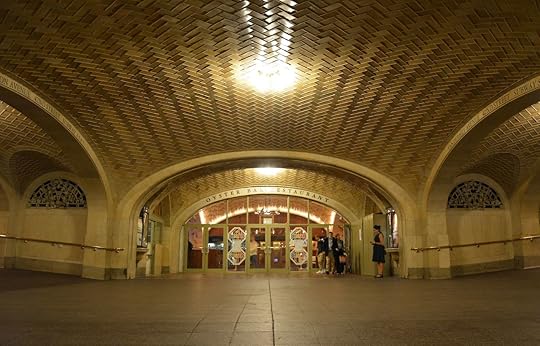
Photo: Alizada Studios/Shutterstock
Grand Central is one of Manhattan’s main transportation hubs, with hundreds of trains and over 700,000 passengers passing through it each day. People mainly pay attention to the terminal’s main concourse, designed as a tunnel vault with gorgeous Beaux Arts architecture, celestial ceiling murals, and large semicircular windows that allow for ample natural light. But off to the side, on a ramp that leads to the lower concourses, is the Whispering Gallery. The archways with Guastavino tile work create an unusual audio effect, allowing a person to stand in one corner and whisper something that can only be heard by someone in the opposite corner. Grand Central is a unique place to take someone special, and heading over to the Whispering Gallery will let you whisper sweet nothings to each other. This allows you both to have a private moment amidst the madness of people creating endless noise.
Where: Right outside of the Oyster Bar inside Grand Central, 89 E 42nd St, New York, NY 10017 

More like this: 6 unique ideas for your next date in NYC
The post 6 uniquely romantic spots around New York City appeared first on Matador Network.

Birds and flowers already on Tonga

It might not be Mars, but scientists have just discovered signs of life on this remote Pacific island, which was recently created by a volcanic eruption. Part of Tonga, and unofficially known as Hunga Tonga-Hunga Ha’apai, the new island is already home to flowering plants, sooty tern birds, and barn owls. The island was formed after a submarine volcano erupted in 2014, sending steam, ash, and rock into the air. After the ash settled, it mingled with seawater to solidify, thereby creating a new island mere months later.
NASA researcher Dan Slayback visited the island in October, and discovered a mysterious light, sticky clay mud on the volcanic mass. In a NASA blog post, he wrote, “We didn’t really know what it was and I’m still a little baffled of where it’s coming from.” Although NASA predicts the island could last between six and 30 years, Slayback believes its time could be even shorter due to erosion. “Rain is having an impact on erosion,” he said, “so if there’s continued heavy rain there’s a real chance it might only be there for a decade or so. But it’s hard to say; if we’re lucky it might be there for longer.”
It’s not the first time an underwater volcanic eruption has created a new island, though these islands usually last less than a few months, and rarely host such vibrant flora and fauna. Volcanologist Jess Phoenix told the BBC, “In this case, the ash seemed to have a chemical reaction with the seawater that allowed it to solidify more than it usually would.” She isn’t, however, totally surprised to find animal and plant life on the island. “It’s likely that it was transported by animals [from surrounding islands],” she said, “most likely through bird droppings, and volcanic land is pretty fertile.” 
H/T: BBC News

More like this: The most amazing islands in Italy you’ve never heard of
The post Brand new Tonga island is already home to gorgeous flora and owls appeared first on Matador Network.

This turkish ghost town

No, it’s not a post-apocalyptic scene from one of Cinderella’s nightmares. This town of 587 identical, castle-like houses located near Mudurnu, a town only 150 miles east of Istanbul, Turkey, actually exists. Originally intended to be a luxury housing development for wealthy Gulf tourists, the Burj Al Babas complex was supposed to include a total of 732 French-style chateaux, along with a shopping center, Turkish baths, cinemas, and sporting facilities.

Photo: Esin Deniz/Shutterstock
Construction started in 2014 and halted in 2018 after developer Sarot Property Group went bankrupt. Each house is said to be worth between $400,000 and $500,000 — only a few of the castle-like homes were sold and investors have pulled out.
Unsurprisingly, Mudurnu locals hate the project, says The Guardian. “It is not in keeping with the area’s traditional architecture, characterized by Byzantine buildings, traditional Ottoman wooden houses, and a 600-year-old mosque.”
It’s unclear when, or if, the remainder of the eerie complex will be finished. 
H/T: Lonely Planet

More like this: 7 castles to visit in France besides Versailles
The post This Turkish ghost town is like a fairytale gone wrong appeared first on Matador Network.

How to travel the Silk Road

Crossing Central Asia overland is undoubtedly faster and less eventful today than it was for sixth-century merchants looking to exchange weapons for spices, but if you’re planning to set out for a transcontinental journey of this kind, it will nevertheless be epic. With modern(ish) methods of transportation available and a relatively calm situation in most countries along the way, traveling the 5,000-mile route connecting east and west is mostly a matter of patience.
What is the Silk Road?
Traveling along the Silk Road today
Know before you go
What is the Silk Road?

If we were to interpret the term literally, the legendary Silk Road should be traversed in only one direction, east to west. Silk originated in China and traveled for months through Central Asia in order to reach Roman hands in Europe, where the natural fabric was considered the ultimate luxury. However, the term “Silk Road” refers to something much larger than the mere exchange of textiles.
Once the Hexi Corridor opened up between Xi’an and Central Asia (around 130 BCE), expanding the trade routes already in place toward the East, merchants began exchanging not only textiles, but spices, tea, precious stones, medicine, weapons, silver, honey, animals, and even slaves at the oases and caravanserais along the route.
While commercial trading fueled the traffic, creating branches that spread out all the way to India, Southeast Asia, and Africa, the network of roads has been particularly valuable for its contribution to the development of modern cultures. Buddhism, for example, was diffused outside of India thanks to these connections.
What we call the Silk Road is, therefore, not a single trackway linking two points on a map, but rather a criss-crossing of routes and paths of trade routes developed over centuries where people flowed and with them, goods, cultures, technologies, and religions.
Dealings on the Silk Road remained active until the late Middle Ages (1453). The discovery of sea routes caused the ultimate decline of land transport and many cities that had gained wealth due to their strategic position lost their fortunes.
Traveling along the Silk Road today
My personal journey along the Silk Road took me all the way from eastern China to Italy through Kyrgyzstan, Uzbekistan, Iran, Turkey, and Greece. After risking an arrest on the border of Turkmenistan because of them not being able to provide me with the much-needed transit visa on time, I had to skip the country with a last-minute flight. The trip, however, is easily doable overland, given that your organizational skills are top-notch.

Generally speaking, the entry point to the Silk Road is Xi’an, in China’s Shaanxi province, while the final stop is in Istanbul, Turkey, at the doorstep of Europe. But there are no strict rules; between the two cities, the itineraries vary and you can explore in any direction you wish. While I decided to head south from Uzbekistan and traverse the Middle East, it is also possible to exit China or Uzbekistan via Kazakhstan and cross the Caspian Sea into the Caucasus. From these two main routes, an almost infinite number of potential detours await.

After a brief stopover in the town of Zhangye, located along the Hexi Corridor and famous for its rainbow-striped rock formations, I recommend that you proceed to the capital city of Ürümqi in the autonomous region of Xianjiang. Western China is perhaps the least stable area along the Silk Road, because of the long conflict between the central government and the local Uyghur population, which still causes bombings and armed attacks from time to time.

Another night on the train takes you to the last of the Chinese cities before Central Asia: Kashgar. A mosque establishes the city center and sand-colored buildings surround the market in which mutton stew has replaced steamed dumplings. The male inhabitants wear square hats and have long beards while most of the women don thick veils. Kashgar is as Chinese as Beijing on the map, but in reality, the two cities and their people could not be any more different.
From Kashgar, in a matter of hours, you can be in Pakistan, Afghanistan, Kyrgyzstan, Kazakhstan, and, a little further, India. A central node in the Silk Road, this city has always seen the intersection between civilizations and is still a vibrant cultural nest today.

A bus ride over spectacular mountain passes leads to Kyrgyzstan, a country of natural wonders that blends nomadic tradition and Soviet history with pristine landscapes. From Osh, the second largest city, you can access Uzbekistan in no time, but it is worth considering a diversion north, to Issyk-Kul Lake and the Tien Shan Mountains. The many jailoos (summer pastures) dotted by yurts set up by nomads in altitude areas are worth the circuitous route.
The Karakol region and the area surrounding Song-Kul Lake are two of the best if you want to make use of the hiking boots you’ve been carrying in your backpack. Signage is lacking, maps are hard to find, and trails are barely visible, but that’s what keeps the place unspoiled.

Since President Shavkat Mirziyoyev replaced his authoritarian predecessor in 2016, Uzbekistan — a formerly closed off country — has opened up toward foreign tourism. Applying for a visa and getting it today is a much smoother process than in the past and this is definitely a situation to be taken advantage of. Uzbekistan is full of amazing sights, including intriguing examples of Islamic architecture, restored to their former glory by the Soviets who despised religion but understood the value of these man-made treasures. Some of the most important centers of the Silk Road are here — starting from Samarkand, a city of turquoise domes founded in the seventh century BCE, to walled fortress of Khiva.

The newly-acquired openness has not extended to Turkmenistan, which allows visitors only a short transit visa (tourist visas involve getting a letter of invitation from the person that you are visiting or permission from a tourist agency with whom you need to book an expensive and guided tour). That said, the country is small and mostly empty, so the five-day permit to cross into Iran is usually more than enough for a short visit. The old Persia, on the other hand, will welcome you with its disarming hospitality and some of the most stunning historical sites on the whole route. After visiting millennia-old castles, restored caravanserais, and remnants of the Zoroastrian tradition, you’ll reach the city of Tabriz, another key node on the Silk Road with its UNESCO-listed brick-covered bazaar, a complex that has seen people from East and West exchanging goods for centuries. From there, it’s smooth sailing all the way to the western tip of Turkey.

Some alternatives exist to the itinerary just described. From the city of Aktau in western Kazakhstan, ferries depart toward Baku, Azerbaijan. From Baku it is necessary, however, to go the long way via Georgia, as both the borders between Azerbaijan and Armenia, and between Armenia and Turkey are closed at the time of writing. For those able to obtain a Russian visa, it is also possible to travel around the Caspian Sea and into the North Caucasus.
Know before you go

Traveling the Silk Road is not another Southeast Asian Banana Pancake Trail — although there are backpackers exploring this corner of the world, you won’t encounter full-moon parties with flaming jump ropes and cheap cocktail buckets. Let’s be grateful for that.
Moving around
Public transport is available in most areas and shared taxis are common in regions not covered by buses or trains. Especially in Kyrgyzstan, it is not unusual to see locals hitchhiking along the road. Traveling by thumb is possible, but remember that people offering a ride will expect you to contribute to fuel costs. Chinese trains are modern and comfortable and the same can be said of Iranian and Turkish buses. Most people still travel overland in this part of the world so finding a connection to your next destination will hardly ever be an issue.
Kyrgyzstan has developed a great Community Based Tourism system, which allows you to find accommodation through local families in every corner of the country. Just walk into one of the CBT offices in the major cities and ask about the options, and regardless of whether you’re looking to reach a remote destination or sleep in a yurt with the locals, it can easily be set up.
While each country has its own tongue and each region its own dialect, the most widely spoken language along the Silk Road is Russian. You can get by with English relatively easily; however, it may be helpful to learn some Cyrillic letters to decipher signs at the very least.
It is not necessary to invest 24 years of your life in this trip like Marco Polo did to complete the journey from Xi’an to Istanbul, but you will need at least two full months, preferably in the summer, if you don’t want to rush through.

Safety
Although many destinations in Central Asia may appear isolated, there is a decent tourist infrastructure in every city along the way. Iran and the ex-Soviet states are safe to visit; however in Xinjiang incidents due to the Chinese–Uyghur conflict occur from time to time. That said, foreign travelers shouldn’t consider the current political situation an obstacle. Xinjiang is a region where the presence of the police is highly felt, checks are frequent, and tanks occupy the streets, but tourists can move freely and are hardly ever bothered.
Uzbekistan used to have strict regulations regarding foreign travelers. Until a few years ago you had to register in every hotel and guesthouse you slept in and show the receipts upon exit at the border. Not providing proof of registration for every night spent in the country could mean arrest or deportation. This is no longer the case. Today you are still required to register at hotels at least once every three nights, but if you plan to camp or couchsurf, it is also possible to use the online service Emehmon to pay your tourist tax.
While Couchsurfing is no longer illegal in Uzbekistan, it is still officially not allowed in Iran. That said, Iran is probably one of the easiest countries to find a host in and many people use Couchsurfing to meet and help each other. If you decide to rely on the online platform to find hospitality, just be aware that it is technically forbidden.

Visas
Although not essential, it’s a good idea to request both your Chinese and Iranian visas in advance in your home embassy in order to save time while on the road. Most embassies will require you to apply no earlier than three months before entering the country, so take this into account if you are planning a longer trip.
During the research stages of your trip you’ll likely come across some nightmare stories of border crossings in Central Asia. Many travelers have had to deal with corrupt police in the past, but today the situation has greatly improved and as long as you play by the rules you will not experience any form of harassment.
Of all the countries along the way, Kyrgyzstan is the easiest to access. This tiny and isolated nation understood quickly the value of letting foreign tourists in and allows citizens of 40 countries to stay for 60 days without a visa. This is particularly useful if you are planning to obtain other permits on the road, as waiting times can be long.
Since February 2019, Uzbekistan has introduced a visa-free regime for all countries of the European Union and Canada, and an electronic visa service for citizens of the United States.
Turkmenistan is still pretty much closed off to the outside world — so much so that it’s been nicknamed the “new North Korea.” In order to get a tourist visa, you need to obtain permission from a tourist agency with whom you need to book a guided tour that costs between $150 and $250 a day. It is possible, however, to obtain a transit visa, which allows crossing the country via two predetermined entry and exit points within three or five days. It is fundamental that you organize this part of your trip some weeks in advance, since the transit visa is date-specific and receiving it may take some time.
Azerbaijan has also activated an online visa service since 2017. It is possible to request your permit through the official website and receive it within hours in your inbox. Just be careful to apply on the right website, as many agencies pretending to be government institutions have set up similar-looking portals where an extra fee is charged for the application service.

Useful Resources
Caravanistan is the richest source of information regarding this part of the world. Each country has a dedicated page with up-to-date documentation and the forum contains many personal accounts of travelers who have passed through the region.
Pleco is a great smartphone application to communicate in Chinese. It offers a dictionary and OCR to scan and translate written words instantly.


More like this: Traveling overland from the very top of Russia to the bottom of Iran
The post How to do the ultimate Silk Road trip appeared first on Matador Network.

Matador Network's Blog
- Matador Network's profile
- 6 followers



